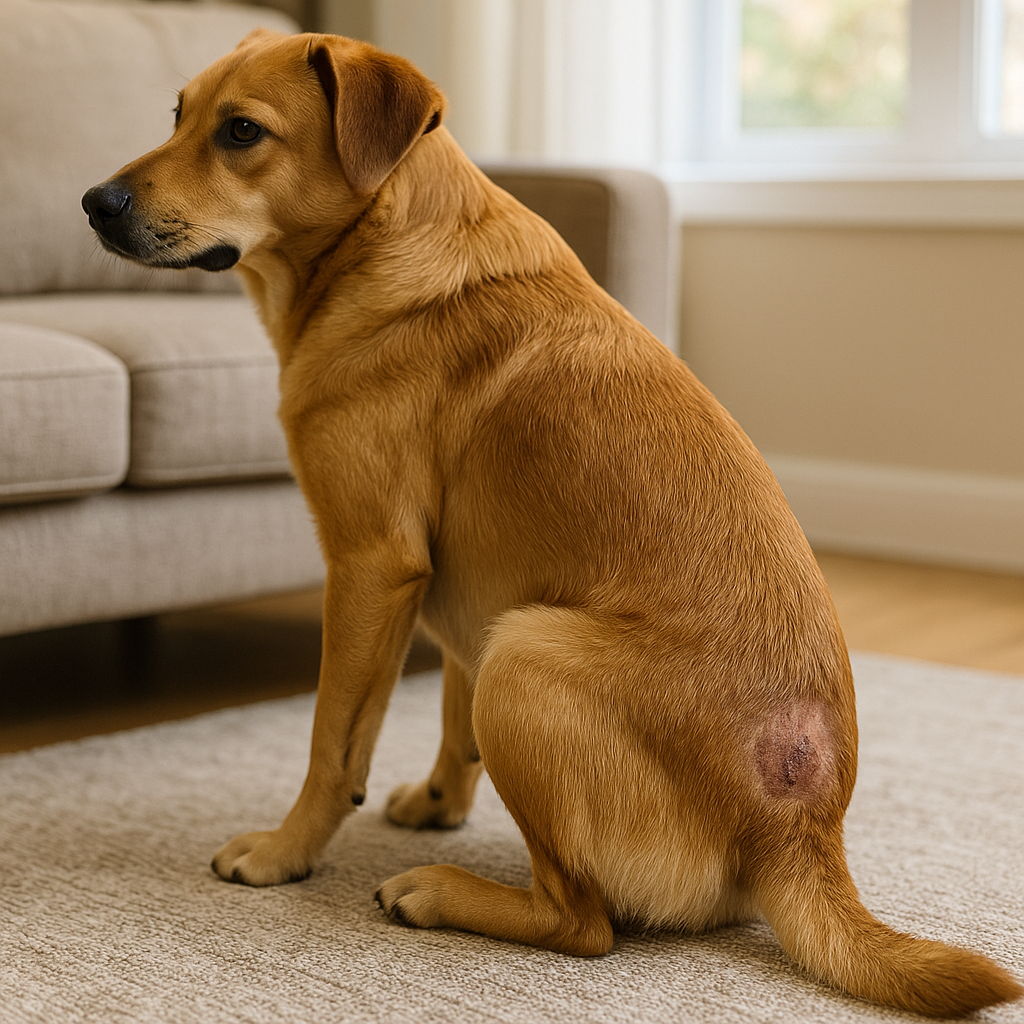
Stud Tail in Dogs: Causes, Signs & Treatment
Stud tail—also called tail gland hyperplasia or supracaudal gland hyperplasia—is a skin condition that targets the oil-producing glands on the top side of the tail near its base. When these glands enlarge and overproduce oil, follicles can plug, hairs fall out, and the skin gets greasy, scaly, and sometimes infected.
Quick take
Looks like: A bald, greasy, sometimes darkened patch on the top of the tail base; may have blackheads, crusts, or discharge if infected. Dogs may lick or chew at it. (To see an image, click here: https://www.kingsdale.com/wp-content/uploads/2023/08/stud-tail-dog-1.jpg)
Who gets it: Any dog, but it’s more common in intact males because androgens (like testosterone) can drive the gland changes. It can also show up with other hormone problems.
Is it serious? Usually cosmetic, but secondary infections are common and uncomfortable. Most cases have a good prognosis with appropriate care.
What causes stud tail?
The supracaudal (tail) gland contains clusters of sebaceous and related “hepatoid” glands. In many dogs with stud tail, excess androgen activity is the driver, which is why intact males are over-represented. Other contributors include seborrhea (greasy skin disorders) and endocrine disease (e.g., Cushing’s disease); rarely, androgen-secreting tumors can play a role.
Why hormones matter
Androgens stimulate growth and secretion in modified sebaceous/hepatoid glands (these glands occur in several spots, including the base of the tail). This hormone link is also why neutering can improve lesions in some dogs.
Signs to watch for
Focal hair loss over the tail base (dorsal side)
Greasiness and follicular plugging/blackheads (comedones)
Scaling, crusts, skin darkening, and skin thickening over time
Redness, swelling, draining tracts if a secondary infection sets in
Itching or chewing focused on the tail base
These are classic clinical features your vet can often recognize on exam.
How your veterinarian confirms it
Diagnosis is usually based on appearance and location. To rule out look-alikes and check for complications, your vet may perform:
Skin cytology to identify yeast/bacteria
Culture if there’s discharge
Skin scraping (mites) and fungal culture (ringworm)
Bloodwork if endocrine disease is suspected
Testicular exam in intact males; advanced imaging if hormone-secreting tumors are a concern
Biopsy is rarely needed but can confirm the diagnosis.
Treatment options
Mild cases (cosmetic only):
Antiseborrheic, degreasing shampoos (e.g., benzoyl peroxide, salicylic acid) as needed to keep the patch clean and oil-free. Follow your vet’s instructions—benzoyl peroxide can be drying, so conditioning rinses may be recommended.
If infection or inflammation is present:
Topical antibiotics for localized mild infections; oral antibiotics for deeper or extensive infection (ideally chosen by culture).
Topical or short courses of oral corticosteroids if the area is inflamed and painful.
E-collar to stop self-trauma while it heals.
Addressing the hormone link:
Neutering can help many intact males; improvement is typically seen within about two months after surgery.
When surgery is discussed:
Rarely, if lesions are severe and don’t respond, surgical removal of affected skin is considered. Tail amputation is very uncommon and reserved for painful, refractory cases.
Home care do’s & don’ts
Do
Bathe the area exactly as your vet directs; allow medicated shampoos their contact time before rinsing.
Rinse thoroughly and use vet-approved conditioners to limit dryness.
Keep fleas and other itch triggers under control.
Don’t
Use harsh solvents or human acne products without veterinary guidance.
Pluck or squeeze blackheads—this worsens inflammation and infection.
(Your vet may tailor frequency and product choices to your dog’s coat/skin type and whether infections are present.)
Prognosis & prevention
The outlook is good. Many dogs need only periodic topical care; those with underlying seborrhea or endocrine disease do best when those conditions are identified and managed. Keeping the area clean, controlling secondary infections quickly, and addressing hormones (when relevant) help prevent flare-ups.
When to see the vet
Rapidly worsening redness, swelling, pain, or discharge
Your dog can’t leave the area alone
New hair loss elsewhere (possible broader skin or hormone issue)
An intact male with a new tail-base bald patch (discuss neutering and rule out testicular disease)
Bottom line
Stud tail is a common, usually manageable skin issue centered on the tail’s oil glands. A proper exam, simple tests, and consistent at-home skin care—plus neutering when appropriate—are the pillars of control. Most dogs are comfortable and back to normal routines with a straightforward plan from your vet.
